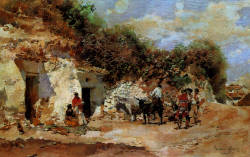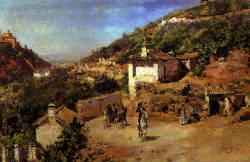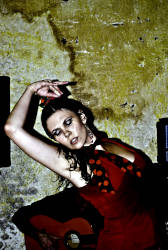Sacromonte




Sacromonte is a neighbourhood in the eastern area of the city of Granada in Andalusia, Spain, a part of the urban district of Albayzín. It is located in a valley, and there is rather soft rock on the northern slope of the valley, which was used to dig cave houses for a long time. As it was far from the city center and caves were considered the homes of poor people it soon became a sort of ghetto, an enclave for mostly gypsy families and for descendants of the moors. Moor is the spanish term for arabs, and it means the muslim occupiers of Spain who were defeated during the reconquista by the catholic armies. As a result they fled, but obviously the richer people were able to pay for the ship and even take some valuable home, but the poor people often stayed. The were forced to convert to the catholic religion and were nevertheless the descendant of oppressors, so they had the lowest status in society. Both lived in this quarter and soon Romani and "moors" mixed.
Those families used the few possibilities they had to have a little fun, and so they had caves which were a little bigger than others for gathering. The family came together with their flamenco dancing and singing which attracted those who passed by. Those daily parties came naturally, without the need to organize it, without the need for a stage, simply in a circle and wherever they were. The walls were decorated with local crafts, there was a row of stools on both sides along the wall. The middle was free for dancing, the far end was occupied by the musicians.
During the 19th century the Flamenco developed and the gypsies were both, the musicians and dancers, and the audience. The local gypsy variation of the Flamenco is called Zambra Gitana or simply Zambra, which is also the name of the cave venues. The word zambra derives from the arabic word zamra (flute) or zamara (musicians). It was frequently used in the literature of the 17th and 18th century with genres such as zapateado, zarabanda and fandango. However, zambra is the own genre of the moors of Granada, with three kinds of dances, the la alboreá (the sunrise), la cachucha (the cap), and la mosca (the fly). The flamenco as we know it today became famous in the 1960s and 70s.
Today there are several of the traditional Zambras in the Sacromonte neighborhood open for the public. They all have the small rectangular cave, with a vaulted ceiling, decorations of local craftwork, pottery and hammered copper, and rows of stools on both sides. Under the name Cuevas del Sacromonte Granada they offer dinner and regular shows every evening. The first which made the transition form a private home to a pub was the Cueva de la Rocío. In 1951, Don Andrés Maya Fajardo and Doña Rocío Fernández Bustamante opened the first Gypsy Zambra.
The crowded situation in the rather small caves was a big problem during Corona. There was simply not enough room to follow the distancing rules, and so the venues were more or less completely closed for more than a year. Now the first have reopened, but as international tourism is still low the visitors are 90 % inland.
 Abadía del Sacromonte
Abadía del Sacromonte La Chumbera
La Chumbera Venta El Gallo
Venta El Gallo Zambra María la Canastera
Zambra María la Canastera Cueva de la Rocío
Cueva de la Rocío Museo Cuevas del Sacromonte
Museo Cuevas del Sacromonte Cueva los Tarantos
Cueva los Tarantos El Templo del Flamenco
El Templo del Flamenco
 Search DuckDuckGo for "Sacromonte"
Search DuckDuckGo for "Sacromonte" Sacromonte - Wikipedia (visited: 26-MAR-2022)
Sacromonte - Wikipedia (visited: 26-MAR-2022) El ’jaleo’ vuelve a las cuevas del Sacromonte
El ’jaleo’ vuelve a las cuevas del Sacromonte  (visited: 26-MAR-2022)
(visited: 26-MAR-2022) Index
Index Topics
Topics Hierarchical
Hierarchical Countries
Countries Maps
Maps